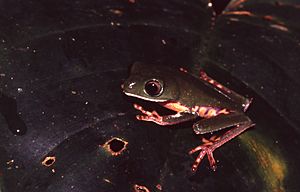Tiger-striped tree frog facts for kids
Quick facts for kids Tiger-striped tree frog |
|
|---|---|
 |
|
| Conservation status | |
| Scientific classification | |
| Synonyms | |
|
The tiger-striped tree frog, officially known as Callimedusa tomopterna, is a type of frog. It belongs to a group of frogs called Phyllomedusinae. You can find this special frog in the northern parts of South America. It lives in the Upper Amazon Basin, which includes countries like Bolivia, Peru, Ecuador, and Colombia. It also lives in the Amazon parts of Brazil and in the Guianas, stretching from southeastern Venezuela to French Guiana. Scientists think there might be more than one kind of tiger-striped tree frog.
This frog loves to live in trees, which is why it's called an arboreal species. It mostly lives in untouched tropical rainforests. You can often find it on trees near temporary pools of water during the wet season. Sometimes, these frogs are also seen in open areas or flooded forests, on bushes and near the edges of water. They live at heights up to 500 meters (about 1,640 feet) above sea level. The tiger-striped tree frog is not very common in most places where it lives. Its home can sometimes be lost due to human activities.
Contents
Life and Behavior
Tiger-striped tree frogs are active at night. This means they are nocturnal. They sleep during the day and wake up when it gets dark. At night, the male frogs make calls to talk to the females. This is also when they look for food.
Reproduction and Eggs
These frogs have a unique way of laying eggs. They place their eggs in a jelly-like mass on green leaves. These leaves hang over standing water. When the eggs hatch, the tadpoles drop into the water below. They then grow and develop there.
Sometimes, there aren't enough good places for frogs to lay eggs. This can lead to different frog species sharing the same spots. It can even cause frogs of different species to try to mate. This happens often with many frogs in the tropics, including the tiger-striped tree frog. Studies have shown that tiger-striped tree frogs have sometimes tried to mate with another frog called the Lesser Treefrog (Dendropsophus minutus).
Challenges for Survival
Tiger-striped tree frogs face some dangers in their lives. Both their eggs and adult frogs can be eaten by predators.
Egg Dangers
In the central Amazon, Phyllomedusa tree frogs lay their eggs in jelly masses on leaves above water. Sadly, more than half of the tiger-striped tree frog egg clutches are attacked. Tiny flies called phorid flies are a big problem. They are the main reason why many egg clutches are lost. Frog eggs are full of protein, which makes them a tasty meal for many predators, especially insect larvae.
Adult Dangers
Adult tiger-striped tree frogs also face dangers from predators. Studies have shown that a snake called the cat-eyed snake (Leptodeira annulate) eats these frogs. This is interesting because tiger-striped tree frogs can release toxins to protect themselves. But these toxins are not always strong enough to stop the cat-eyed snakes.
See also
 In Spanish: Phyllomedusa tomopterna para niños
In Spanish: Phyllomedusa tomopterna para niños


